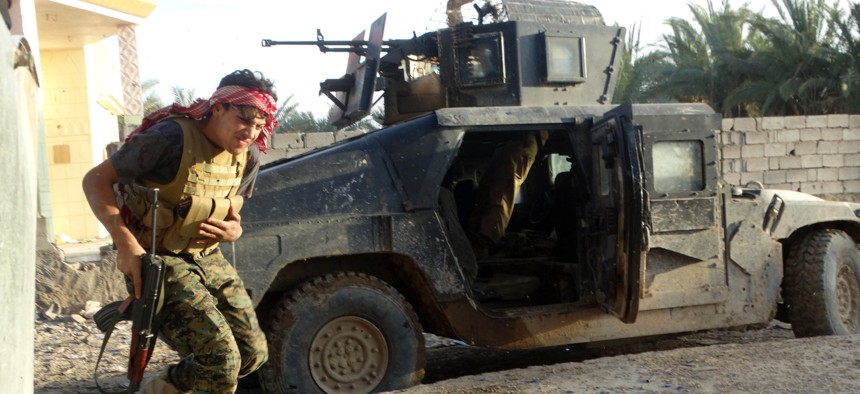
Iraqi security forces take combat positions at the front-line with Islamic State group militants as Iraqi Army and allied Sunni volunteer tribal fighters supported by U.S.-led coalition airstrikes on Ramadi, the capital of Iraq's Anbar province, 70 miles AP / OSAMA SAMI
The US Is Relying on Iraqis to Keep Tabs on ISIS Bomb Technology
New tactics in Iraq make the Paris attacks look quaint, but the drawn-down US force needs local help to keep up.
The Paris bombings sent shivers through law-enforcement agencies around the world — but to Lt. Gen. Michael Shields, they’re just another innovation by skilled ISIS bombmakers. As head of the Pentagon’s Joint Improvised-Threat Defeat Agency, or JIDA, Shields tracks such developments — and is rushing to help Iraqi Security Forces analyze and report on the bombs they encounter.
JIDA’s efforts to track ISIS’s bomb-making prowess are hampered by the U.S. military’s limited presence in Iraq, where it must rely on that country’s security forces to gather intel and conduct forensic investigations after blasts. “Reporting has got to improve,” he said.
In a conversation with reporters at Fort Belvoir last week, Shields described ISIS as an army of fighters who use explosives to make themselves far more lethal than regular soldiers. He called the group “very organized” in its bomb-making, able to churn out IEDs on an industrial scale.
“It’s not a terrorist organization that’s using them to achieve a terrorist effect. They’re using them in vast quantities to isolate and shape the battlespace, almost in phased types of operations. They’re covering them with observation and fires and so on,” he said, meaning in concert with snipers. “It’s caused the Iraqis to re-think how we deal with this threat. It’s less about [explosive ordnance disposal] teams going forth to deal with a device. It’s about combined arms maneuver and combined arms breaching.”
He described ISIS soldiers using cars like missiles.
“Imagine belts of IEDs—not a device—belts of IEDs used to shape the battlespace, using suicide, vehicle-borne improvised explosive devices as their precision guided munitions … and an incredible capacity to produce many of them — ten, twenty, thirty — in an individual attack.”
He also cited “their innovative use of crush switches in buildings, their ability to use vehicle-borne devices and booby-trap rig house-borne IEDs, anti-tamper, anti-lift, motion sensor. Those types of things. Not overly sophisticated in terms of technology but a variety that achieves a comprehensive effect. That is different from what we fought back when I was a brigade commander.”
In the wake of the U.S. drawdown in Iraq, the United States military has fewer boots on the ground to keep track of ISIS’ new tools and tactics using JIDA designed equipment. So JIDA officials are training and equipping Iraqi Security Forces to report on and analyze explosive attacks.
That includes helping security forces know “what to report,” Shields said.
To make that reporting easier, JIDA is backing a new system called Virtual Advise and Assist, which agency officials unveiled in June described as “Skype for the battlefield,” It’s a tablet-based portal that Iraqi Security Forces or others can use to collect post-blast data, then send it to U.S. or coalition partners for further analysis.
“Due to the new operational constraints of Coalition Forces to Advise & Assist partner nations and not have forces outside of the wire, it is imperative to provide partner nations with a capability to enable them to collect information and also see information shared by Coalition Forces. The concept is deployed in order to accomplish those objectives and fill in the current information gap for coalition forces,” JIDA said in a statement. That could help analysts better categorize new IEDs, an essential step to building the technology to detect them.
Virtual Advise and Assist has been sent to Iraq as part of a proof-of-concept research effort but it’s still in testing, not fully deployed for use by troops. Another version has been sent to Afghanistan and a third to Africa.
JIDA, formerly the Joint Improvised Explosive Device Defeat Organization, or JIEDDO, has shrunk in just a few years from 3,000 people and a $4 billion budget to 1,000 people and $500 million in 2015. Yet it has also become more relevant. U.S. troops aren’t encountering IEDs on the front lines in Iraq, as they were in 2007. But just because the military has left doesn’t mean the threat is gone, as shown by the events of this week.




